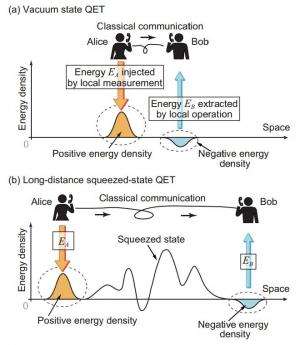January 28, 2014 report
New theory suggests way to teleport energy long distances

(Phys.org) —A trio of researchers at Tohoku University in Japan, led by Masahiro Hotta, has proposed a new way to teleport energy that allows for doing so over long distances. In their paper published in Physical Review A, the team describes a theory they've developed that takes advantage of the properties of squeezed light or vacuum states to allow for "teleporting" information about an energy state, allowing for making use of that energy—in essence, teleporting energy over long distances.
On television shows such as Star Trek, people are moved from one location to another via teleportation, where the people (or objects) are not literally sent—instead their essence is reestablished in another local, giving the illusion of movement. In real life, nothing like that exists, though scientists have begun using the term teleportation to describe the results of entanglement experiments—where two entangled particles are joined somehow despite no apparent connection between them. Changes to one particle happen automatically to the other. Scientists have broadened their experiments to include light and matter, and more recently, energy.
Back in 2008, Hotta, with another team, first devised a theory for teleporting energy based on taking advantages of vacuum states—theory suggests they are not truly empty, instead there are particles in them that pop in and out of existence, some of which are entangled. While interesting, the theory suggested that teleporting energy could only be carried out over very short distances. In this new effort, Hotta et al have found a way to increase the teleportation distance by making use of a property known as squeezed light which is tied to a squeezed vacuum state.
Quantum mechanics laws limit the ways that values in a system (such as a vacuum) can be measured—physicists have found however, that increasing the uncertainty of one value, decrease the uncertainty of the value of others—a sort of squeezing effect. When applied to light, theory suggests, it leads to more pairs traveling together through a vacuum, which in turn leads to more of them being entanglement, and that the team suggests should allow for teleporting energy over virtually any distance.
The researchers suggest their theory could be put to the test in a lab and Hotta hints that he and another partner are in the process of doing just that.
More information: Quantum energy teleportation without a limit of distance, Phys. Rev. A 89, 012311 (2014) DOI: 10.1103/PhysRevA.89.012311 . On ArXiv: arxiv.org/abs/1305.3955
Abstract
Quantum energy teleportation (QET) is, from the operational viewpoint of distant protocol users, energy transportation via local operations and classical communication. QET has various links to fundamental research fields including black-hole physics, the quantum theory of Maxwell's demon, and quantum entanglement in condensed-matter physics. However, the energy that has been extracted using a previous QET protocol is limited by the distance between two protocol users; the upper bound of the energy being inversely proportional to the distance. In this paper, we prove that introducing squeezed vacuum states with local vacuum regions between the two protocol users overcomes this limitation, allowing energy teleportation over practical distances.
Journal information: Physical Review A , arXiv
© 2014 Phys.org



















